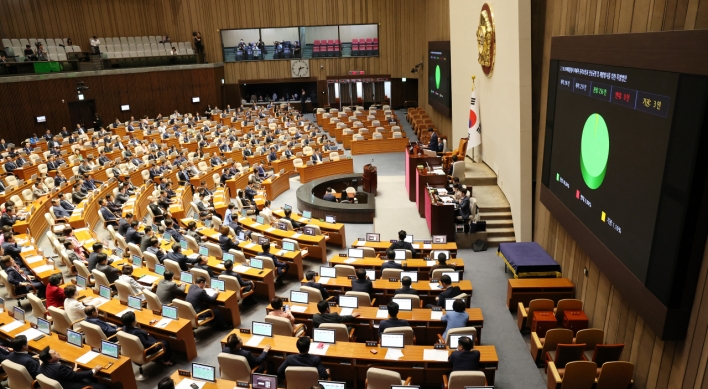[Herald Design Forum 2019] An alternative approach to urban rejuvenation
By Shim Woo-hyunPublished : Oct. 7, 2019 - 18:04
Instituting an urban renewal plan, especially in a top-down manner, runs the risk of disregarding the actual needs of the people living in the city, or missing the potential benefits that can be derived when the community is engaged in the redevelopment process.
The London-based studio Assemble takes a bottom-up approach, setting out to reinvigorate urban areas in ways that benefit communities.
Founded in 2010, Assemble boasts a diverse and award-winning body of work. Its democratic and cooperative working method enables the team to produce research-based work at a variety of scales.
Assemble’s landmark projects include the Goldsmiths Centre for Contemporary Art in London and the 2015 Turner Prize winner, the Granby Four Streets project.
Maria Lisogorskaya is one of the founding members of Assemble, a multidisciplinary collective that works across the fields of architecture, design and art.
At this year’s Herald Design Forum, Lisogorskaya will share her thoughts and experiences around projects she has been involved in, including the Granby Four Streets project and the more recent Material Institute project in New Orleans.
The London-based studio Assemble takes a bottom-up approach, setting out to reinvigorate urban areas in ways that benefit communities.
Founded in 2010, Assemble boasts a diverse and award-winning body of work. Its democratic and cooperative working method enables the team to produce research-based work at a variety of scales.
Assemble’s landmark projects include the Goldsmiths Centre for Contemporary Art in London and the 2015 Turner Prize winner, the Granby Four Streets project.
Maria Lisogorskaya is one of the founding members of Assemble, a multidisciplinary collective that works across the fields of architecture, design and art.
At this year’s Herald Design Forum, Lisogorskaya will share her thoughts and experiences around projects she has been involved in, including the Granby Four Streets project and the more recent Material Institute project in New Orleans.

Granby Four Streets is a community-led project to rebuild Granby, a Liverpool neighborhood that was practically in ruins after decades of poorly planned regeneration initiatives.
For this still ongoing rejuvenation project, this year Assemble opened the Granby Winter Garden in two houses in the community.
This new space includes a seasonal garden, an event space and an artist’s residence, which is intended to nurture creative practice in the town.


This year Assemble is engaged with another rejuvenation project in New Orleans, where the group and the community are working together to transform an old industrial property into a fashion hub for the local community -- a place to learn about fashion and about the design and manufacturing of garments and textiles.
Assemble began its project in New Orleans in 2016, together with an art school supported by the Museum of Old and New Art in Hobart, Australia. Assemble conducted research and had a series of conversations with the local community to come up with a consensus.
The Material Institute is one of the outcomes. International artists and designers also took part in the project, in keeping with the city’s history of Mardi Gras and its annual NOLA Fashion Week.
They worked on abandoned industrial structures and buildings in disenfranchised areas in the city’s St. Roch area, a 10-minute drive from the well-known French Quarter.
A discarded garage was turned into a workspace with exposed concrete floors and white-painted walls, while the beams were painted orange and the ceilings mint green to highlight the new function of the space and add an exotic, tropical vibe.
Several windows and doorways at the institute appear as if they were punched through. They were created by removing cinder blocks from the walls and replacing them with glass.
The goal of the Material Institute is to provide space, tools and professional guidance to those who would otherwise not have access to these opportunities, according to Lisogorskaya.
Since it opened, the institute has offered free education and the chance to engage in hands-on experimentation in both traditional craft and high fashion. Its facilities feature sewing machines, a large dye sublimation printer and heat press, a weaving loom and natural dye lab tools.
By Shim Woo-hyun (ws@heraldcorp.com)
-
Articles by Shim Woo-hyun




![[Music in drama] Rekindle a love that slipped through your fingers](http://res.heraldm.com/phpwas/restmb_idxmake.php?idx=644&simg=/content/image/2024/05/01/20240501050484_0.jpg&u=20240501151646)

![[New faces of Assembly] Architect behind ‘audacious initiative’ believes in denuclearized North Korea](http://res.heraldm.com/phpwas/restmb_idxmake.php?idx=644&simg=/content/image/2024/05/01/20240501050627_0.jpg&u=20240502093000)


![[KH Explains] Will alternative trading platform shake up Korean stock market?](http://res.heraldm.com/phpwas/restmb_idxmake.php?idx=644&simg=/content/image/2024/05/01/20240501050557_0.jpg&u=20240501161906)









